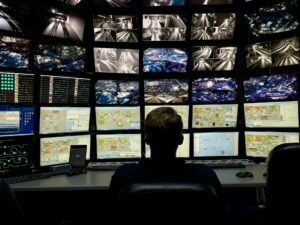The Emergence of Newsrooms Operated by Artificial Intelligence: Are Algorithms Capable of Taking the Place of Journalists?

The Emergence of Newsrooms Operated by Artificial Intelligence: Are Algorithms Capable of Taking the Place of Journalists?
The newsroom has always been a place where the public may get information. In the past, journalists were responsible for conducting investigations, reporting on their findings, and shaping narratives that provided the public with information. However, over the course of the last several years, Artificial Intelligence (AI) has begun to take on a more and more prominent role in the process of producing news. Artificial intelligence-generated newsrooms are becoming a reality, since they are capable of doing tasks such as writing sports summaries in a matter of seconds and automating financial reporting. This technological revolution brings up an essential point that must be addressed: Will computers ever be able to completely replace human journalists, or will they continue to serve as aids in the art of storytelling?
1. The Appearance of Artificial Intelligence in Newsrooms
The use of artificial intelligence in journalism first started with data-heavy reporting, in which speed and accuracy were of the utmost importance. The creation of weather predictions, financial profit reports, and sports outcomes were all accomplished by early adopters via the application of artificial intelligence (AI). As the years have gone by, AI systems have been able to produce articles that are more detailed and complex, making it increasingly difficult to distinguish between reporting done by humans and that done by machines. This has been made possible by the progress that has been made in machine learning and natural language processing (NLP).
2. The Functioning of Newsrooms that Utilize Artificial Intelligence
Platforms that provide news that is powered by artificial intelligence (AI) are dependent on data collecting, natural language generation (NLG), and contextual analysis. It is possible for computers to develop storylines, generate headlines, and even include a certain amount of creative flare by extracting raw data from sources that are considered to be reliable. Depending on the intended audience, some sophisticated systems have the ability to adjust their tone, resulting in the creation of several iterations of the same tale.
3. Benefits of Artificial Intelligence in the Journalism Industry
The emergence of newsrooms that are powered by artificial intelligence (AI) presents a number of advantages:
- Speed and Efficiency: Artificial intelligence (AI) is capable of generating news stories in a matter of seconds, which means that it can report on events more quickly than human reporters.
- Algorithms are able to create thousands of articles that are localized at the same time, which provides coverage that would be hard for human teams to do on their own. This is known as scalability.
- Cost Reduction: Media outlets may cut their labor expenses by automating repetitious reporting duties.
- Insights Based on Data: Artificial intelligence (AI) is capable of analyzing massive datasets in order to identify patterns and trends that human reporters may not see.
4. Restrictions on Reporting by Algorithms
The use of journalism that is created by artificial intelligence (AI) is not without its drawbacks, despite the fact that it offers a number of benefits. The intricacies of language, cultural background, and emotional resonance are all difficult for algorithms to work with. They are not able to perform investigative journalism, interview sources, or apply moral judgment to difficult matters. When artificial intelligence (AI) is used excessively, there is a danger that the information produced will be superficial and formulaic and that it will lack the depth that consumers expect from professional writing.
5. Cooperation Between People and Artificial Intelligence in Newsrooms
Artificial intelligence is being used more and more often to provide assistance to journalists, rather than to take their place. For example, artificial intelligence can perform repetitious reporting, which frees up human journalists to concentrate on more complicated investigations, feature writing, and editorial analysis. A hybrid paradigm is being embraced by a large number of newsrooms, in which artificial intelligence (AI) instruments perform the functions of research assistants, data analysts, and first-draft writers.
6. Ethical Considerations and Challenges with Trust
The employment of artificial intelligence in journalism brings up problems about openness and responsibility. It is possible that readers will not be able to determine if an article was authored by a person or by an algorithm. This failure to provide information has the potential to damage confidence, particularly in an era that is already rife with deepfakes and disinformation. In order to retain confidence, both ethical norms and explicit labeling will be essential.
7. The Impact on Employment in Journalism
The displacement of employees is one of the most significant issues about the use of artificial intelligence in newsrooms. New possibilities are becoming available for journalists who have expertise in digital storytelling, data analysis, and artificial intelligence (AI) monitoring, even as the number of ordinary reporting positions is likely to decrease. The profession is not going away; rather, it is developing, which means that journalists must stay up to date with the latest technology innovations.
8. Expectations of the Audience in the Digital Age
Readers in today’s world anticipate receiving immediate updates, news feeds that are tailored to their interests, and information that allows for interaction. Artificial intelligence (AI) assists in satisfying these requirements by selecting stories based on the tastes of users and by providing updates as they happen. However, viewers also desire authenticity and human insight—qualities that robots cannot mimic. The future of the news industry will be determined by finding the appropriate equilibrium.
9. The Future of Newsrooms That Use Artificial Intelligence
In the future, artificial intelligence (AI) will probably assume an even more significant role in the generation of news. It is possible that we may see artificial intelligence (AI) systems doing live translations, making multimedia reports, and even providing hyper-localized news that is suited to specialized groups. That being said, investigative journalism, editorial judgment, and narrative will continue to be controlled by humans, guaranteeing that the human voice continues to be the central component of the field of journalism.
AI-generated newsrooms offer both an opportunity and a problem. Although algorithms are capable of doing tasks with great speed, size, and efficiency, they are unable to completely replace the need for critical thinking, ethical judgment, and human connection in the field of journalism. It seems more possible that artificial intelligence (AI) will change the journalism profession into a collaborative paradigm, in which robots perform monotonous chores while people concentrate on creativity and truth-seeking, rather than replace journalists altogether. Man vs machine will not be the scenario that defines the future of journalism. Instead, it will be a world in which humans and machines collaborate to provide news that is better, quicker, and more dependable.




